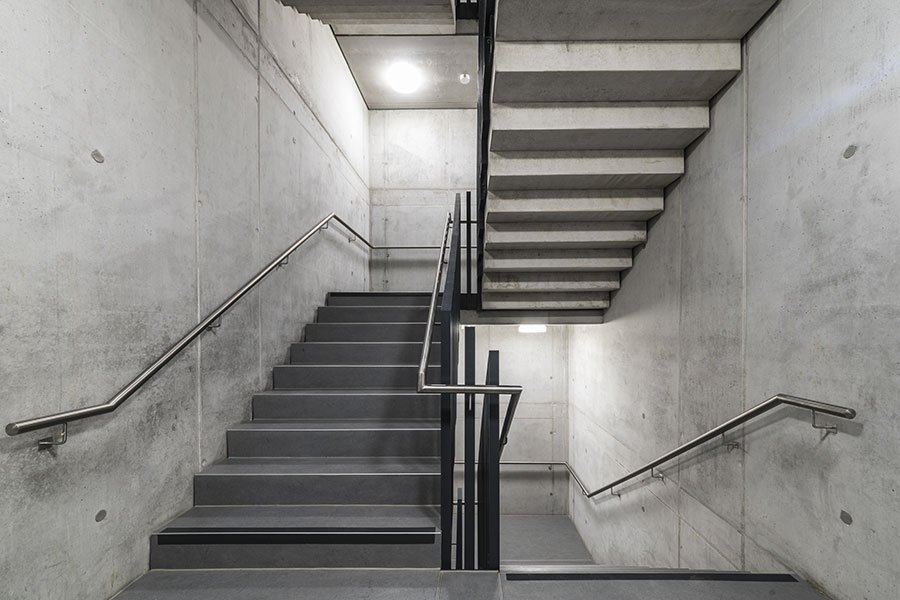Basics of SHEV systems in stairwells
SHEV control centers are lifesavers in the event of a fire and are therefore absolutely essential in public buildings. This makes the correct installation of the smoke and heat exhaust system all the more important.
In Part 1 of this series, we look at the individual components of a typical stairwell SHEVS. Here we use a system from the company Aumüller Aumatic GmbH.
In part 2 we describe in detail the connection of the used components. Read more here Connection of a staircase SHEV control panel
The standard case
If we assume the standard case of a smoke and heat extraction system in a stairwell (applies in 90% of all cases), there is a smoke and heat extraction control panel and a smoke and heat extraction pushbutton on the upper floor, as well as a drive matching the window. On the first floor we find another SHEV button right by the entrance. Now and then a smoke detector is required, this is then also mounted on the upper floor. An optional vent button can be mounted anywhere, and is used, for example, to open the window for ventilation in the summer. Also optional is a connected wind/rain detector, which closes the window opened for ventilation in case of rain or storm.

Individual components
The SHEV control panel
The SHEV control panel is the control unit of this system. It has two rechargeable batteries that ensure that the SHEVS continue to function for 72 hours in the event of a power failure and monitors the lines to the SHEV buttons, the smoke detector and the window drive for short circuits and interruptions. It can transmit messages to a building management system ("SHEV triggered", "Fault") and is triggered by an existing fire alarm system using a connection module.
It also has connections for ventilation pushbuttons with the lowest priority, a connection for a wind/rain detector with medium priority, and triggers with the highest priority in the event of a SHEV, i.e. opens the window even if it is windy or rainy - if there is a fire.
The SHEV button
The SHEV buttons are mostly available in the color orange, but also in the colors yellow, red, blue and gray. Please clarify the color beforehand, there are different specifications.
SHEV buttons are available as main and auxiliary control stations. Main control stations contain, in addition to the release button behind a glass pane and a red LED, a green and a yellow LED for signaling operational readiness (green) and a fault or maintenance reminder (yellow). Furthermore, after opening the door, there is a button for resetting the system and closing the window again. Slave control panels have only one release button and the corresponding red LED.
They require at least one main control panel for fault indication. This is usually installed on the first floor near the main entrance.
It is essential that the SHEV buttons match the main control panel, those from other manufacturers will not work.

The smoke detector
If you are required to install a smoke detector, we recommend that you install one on each floor. A single smoke detector mounted at the very top will detect a fire in the entrance area very late.
It is important that the smoke detector must match the control panel. Be sure to use the smoke detectors specified by the manufacturer as accessories, otherwise false triggering may occur or the triggering will not work.
The drive
It is essential that the drive fits the window. Depending on whether you have a bottom-hung window, a side-hung window or a skylight dome, the drive must be able to open the opening element far enough to ensure the required geometric smoke extraction area. We have summarized more information on calculating the geometric smoke ventilation area in this blog post.
Our product finders will help you find the right drive after entering the necessary data for your window/dome light. You can find our product finders here:
The wind/rain detector
It is also possible that only a rain detector is connected if monitoring of the wind strength is not desired.
A rain detector provides a potential-free contact and switches immediately when it rains, and after a delay of about 5 minutes when the rain has subsided and the sensor surface has dried.
Wind detectors emit pulses, using either a reed contact or Hall transducer, depending on the manufacturer. The wind response threshold is adjustable (via software in this system). Wind sensors must be approved by the manufacturer of the SHEV system.
The fan button
Basically any series button can be used here. It is also possible to use a switch actuator (two potential-free make contacts) of any smart home system instead of a pushbutton.
This EMB 7300 SHEV control panel described here also offers the option of connecting fan pushbuttons with Open and Close indication (two LEDs). In this case, however, use the pushbutton from the company Aumüller Aumatic GmbH.
Our video for the project
Here we show and explain in detail how to properly connect and commission a system from Aumüller Aumatic GmbH. We go into detail about all components and discuss the connection diagrams of the buttons, smoke detectors and the wind/rain control.
The system presented here is from the company Aumüller Aumatic GmbH - for this we have installed the following components:









